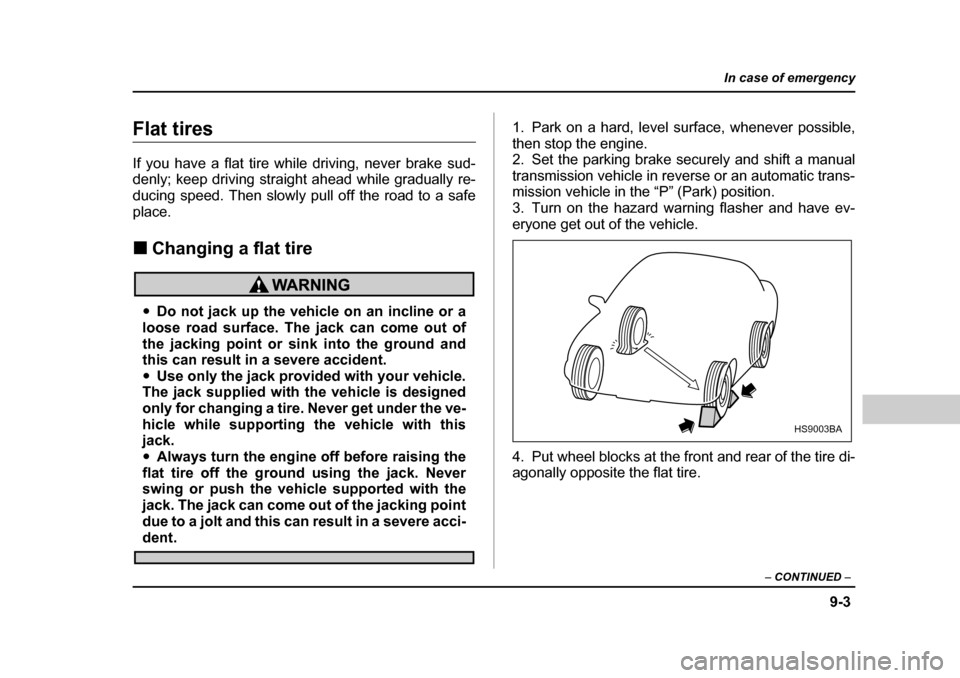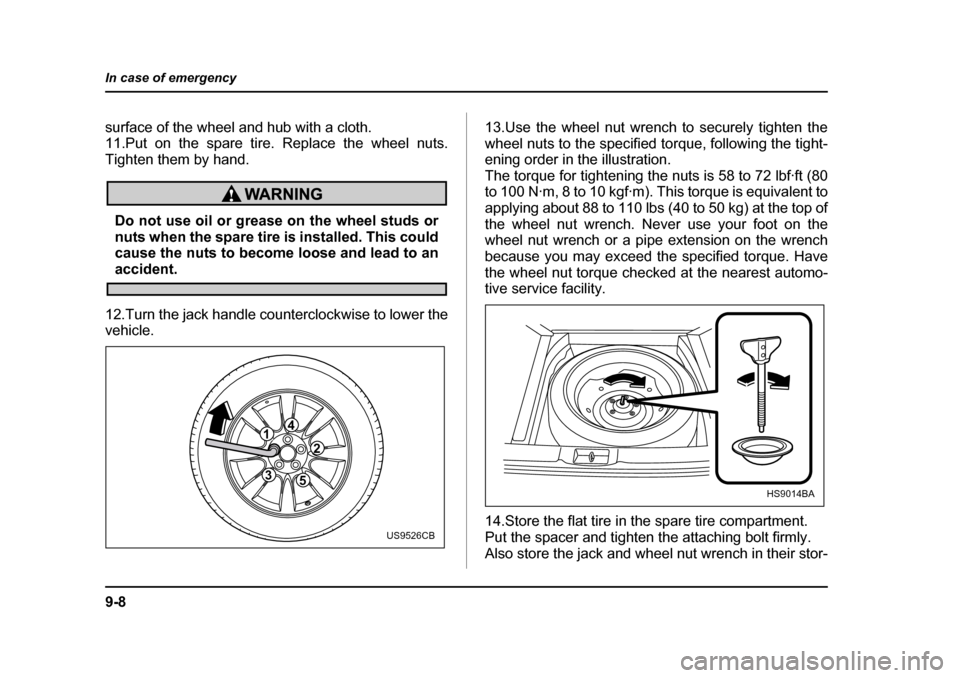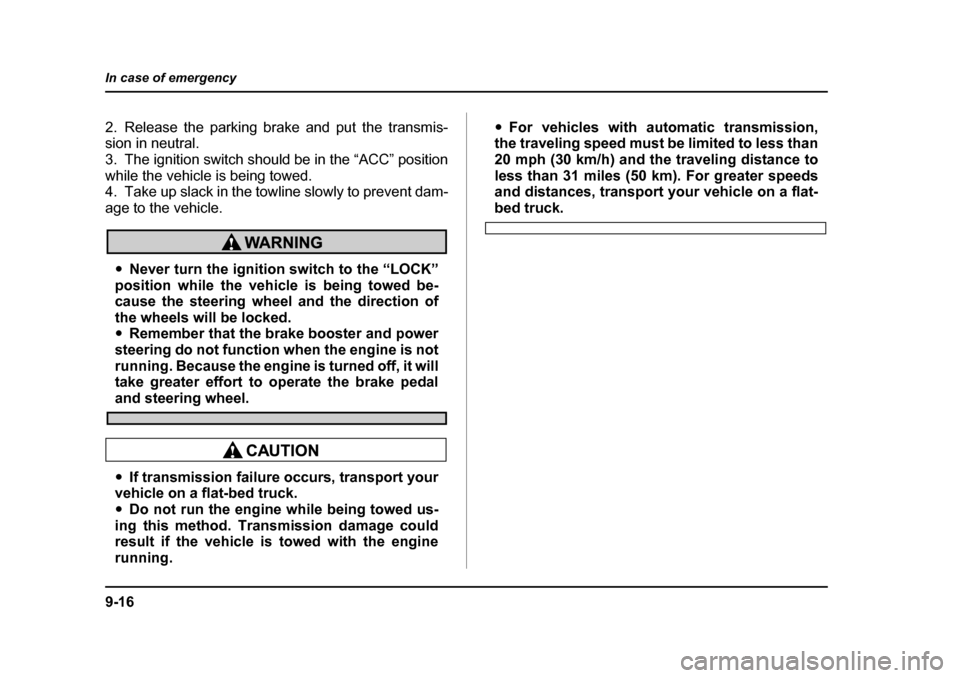Page 338 of 477

9-1
9
In case of emergency
If you park your vehicle in case of an emergency ............................................ 9-2
Flat tires ......................................................... 9-3 Changing a flat tire ........................................... 9-3
Jump starting ................................................ 9-9 How to jump start ............................................. 9-10
Engine overheating ....................................... 9-12 If steam is coming from the engine compartment .................................................. 9-12
If no steam is coming from the engine compartment .................................................. 9-12
Towing ........................................................... 9-13 Towing and tie-down hooks ............................ 9-13
Using a flat-bed truck ....................................... 9-15
Towing with all wheels on the ground ............ 9-15
Rear gate – if the rear gate cannot be unlocked ..................................................... 9-17
Moonroof – if the moonroof cannot be closed ......................................................... 9-18
Maintenance tools ......................................... 9-19 Jack and jack handle ........................................ 9-19
Page 340 of 477

9-3
In case of emergency
– CONTINUED –
Flat tires
If you have a flat tire while driving, never brake sud-
denly; keep driving straight ahead while gradually re-
ducing speed. Then slowly pull off the road to a safe
place. �„Changing a flat tire
�yDo not jack up the vehicle on an incline or a
loose road surface. The jack can come out of
the jacking point or sink into the ground and
this can result in a severe accident.�y Use only the jack provided with your vehicle.
The jack supplied with the vehicle is designed
only for changing a tire. Never get under the ve-
hicle while supporting the vehicle with this jack. �y Always turn the engine off before raising the
flat tire off the ground using the jack. Never
swing or push the vehicle supported with the
jack. The jack can come out of the jacking point
due to a jolt and this can result in a severe acci-
dent. 1. Park on a hard, level surface, whenever possible,
then stop the engine.
2. Set the parking brake securely and shift a manual
transmission vehicle in reverse or an automatic trans-
mission vehicle in the “P” (Park) position.
3. Turn on the hazard warning flasher and have ev-
eryone get out of the vehicle.
4. Put wheel blocks at the front and rear of the tire di-
agonally opposite the flat tire.
HS9003BA
Page 341 of 477
9-4
In case of emergency
A) Jack
B) Jack handle
C) Spare tire
5. Take out the spare tire, jack, and wheel nut wrench.
The spare tire is stored under the floor of the cargo ar-
ea.
To remove the spare tire:
Open the lid and hang the hook provided on the under
side of the lid on the rear edge of the roof to keep the
lid open.
Remove the storage bucket. Turn the attaching bolt
counterclockwise, then take spare tire out. A) Storage bucket
B) Attaching bolt
C) Spare tire
The jack is stored under the left side of the cargo floor.
A
C
B
HS9005BC
A
BC
HS9004BC
Page 342 of 477
9-5
In case of emergency
– CONTINUED –
To take out the jack:
First raise the cargo tie-down hook on the rear-left side
of the cargo area and pull the tab to open the lid, turn
the jack screw counterclockwise to loosen it, then re-
move the jack. To take out the jack handle:
Open the rear-left and center lids in the cargo area by
pulling their tabs.
HS9006BAHS9007BA
Page 345 of 477

9-8
In case of emergency
surface of the wheel and hub with a cloth.
11.Put on the spare tire. Replace the wheel nuts.
Tighten them by hand.
Do not use oil or grease on the wheel studs or
nuts when the spare tire is installed. This could
cause the nuts to become loose and lead to an
accident.
12.Turn the jack handle counterclockwise to lower the
vehicle. 13.Use the wheel nut wrench to securely tighten the
wheel nuts to the specified torque, following the tight-
ening order in the illustration.
The torque for tightening the nuts is 58 to 72 lbf·ft (80
to 100 N·m, 8 to 10 kgf·m). This torque is equivalent to
applying about 88 to 110 lbs (40 to 50 kg) at the top of
the wheel nut wrench. Never use your foot on the
wheel nut wrench or a pipe extension on the wrench
because you may exceed the specified torque. Have
the wheel nut torque checked at the nearest automo-
tive service facility.
14.Store the flat tire in the spare tire compartment.
Put the spacer and tighten the attaching bolt firmly.
Also store the jack and wheel nut wrench in their stor-
3
412
5
US9526CB
HS9014BA
Page 349 of 477

9-12
In case of emergency
Engine overheating
Never attempt to remove the radiator cap until
the engine has been shut off and has fully
cooled down. When the engine is hot, the cool-
ant is under pressure. Removing the cap while
the engine is still hot could release a spray of
boiling hot coolant, which could burn you very
seriously.
If the engine overheats, safely pull off the road and
stop the vehicle in a safe place. �„ If steam is coming from the engine
compartment
Turn the engine off and get everyone away from the
vehicle until it cools down. �„ If no steam is coming from the engine
compartment
1. Keep the engine running at idling speed.
2. Open the hood to ventilate the engine compart- ment. Confirm that the cooling fan is turning. If the fan is not
turning, immediately turn the engine off and contact
your authorized dealer for repair.
3. After the engine coolant temperature has dropped,
turn off the engine.
If the temperature gauge stays at the overheated
zone, turn the engine off.
4. After the engine has fully cooled down, check the
coolant level in the reserve tank.
If the coolant level is below the “LOW” mark, add cool-
ant up to the “FULL” mark.
5. If there is no coolant in the reserve tank, add cool-
ant to the reserve tank. Then remove the radiator cap
and fill the radiator with coolant.
If you remove the radiator cap from a hot radiator, first
wrap a thick cloth around the radiator cap, then turn
the cap counterclockwise slowly without pressing
down until it stops. Release the pressure from the ra-
diator. After the pressure has been fully released, re-
move the cap by pressing down and turning it.
Page 353 of 477

9-16
In case of emergency
2. Release the parking brake and put the transmis-
sion in neutral.
3. The ignition switch should be in the “ACC” position
while the vehicle is being towed.
4. Take up slack in the towline slowly to prevent dam-
age to the vehicle.
�y
Never turn the ignition switch to the “LOCK”
position while the vehicle is being towed be-
cause the steering wheel and the direction of
the wheels will be locked.�y Remember that the brake booster and power
steering do not function when the engine is not
running. Because the engine is turned off, it will
take greater effort to operate the brake pedal
and steering wheel.
�y If transmission failure occurs, transport your
vehicle on a flat-bed truck. �y Do not run the engine while being towed us-
ing this method. Transmission damage could
result if the vehicle is towed with the engine
running. �y
For vehicles with automatic transmission,
the traveling speed must be limited to less than
20 mph (30 km/h) and the traveling distance to
less than 31 miles (50 km). For greater speeds
and distances, transport your vehicle on a flat-
bed truck.
Page 354 of 477
9-17
In case of emergency
– CONTINUED –
Rear gate – if the rear gate cannot be
unlocked
In the event that you cannot unlock the rear gate by
operating the power door locking switches or the re-
mote keyless entry system, you can unlock it from in-
side the cargo area.
0
1. Remove the access cover at the bottom-center of
the rear gate trim. 2. Locate the rear gate lock release lever behind the
rear gate trim panel.
3. Unlock the rear gate by pressing the lever inside
the trim upward.
4. Open the rear gate from outside by raising the rear
gate handle.
HS9025BA
HS9026BA